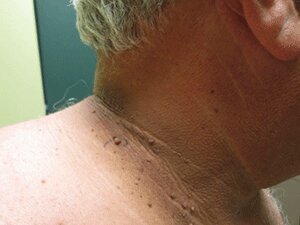Papillary ulcers cause a lot of discomfort only due to external changes in the skin. Most papillomas are at risk of injury, including friction and infection. All of these factors can provoke widespread rashes and tumor cells in the neoplasm. Before starting treatment, a mandatory diagnosis is made to determine the causes and nature of the formation. What causes papillomas in the body, and what does the body tell us? Let's understand it in this article.
Papillomas in the body - what do they mean, what does the body say?

Papillomas in the body represent only one indisputable fact - a person has become a carrier of papillomavirus infection with a progressive course. The main route of transmission is through sexual contact, but it can also be transmitted through kissing, shaking hands, or sexual contact.
The types of known papillomas in the body differ from each other in structural features, color, size and density. Of course, not all carriers of a viral infection suffer from multiple or the same body heat. Activation of pathogenic viral activity is usually associated with a steady decline in immunity.
Some patients compare papillomas to moles, but papillomas have a number of fundamental differences:
- presence of vascular component;
- Preferred location in areas of friction, sweating;
- Loose and soft structure.
Papilloma is similar to papillary growth in the pedicle. The main risk of papilloma is the development of skin cells into cancer.
The risk group includes patients with worsening clinical and life-threatening diseases, as well as those with close relatives with cancer.
Papillomas are a rare disease and cause concern without causing local symptoms. Clinics call such neoplasms "time bombs" that appear spontaneously under the influence of various negative factors.
The virus may not appear for years, but it is still a carrier of the infection, even if the person has a strong immune system. Often, men are to blame for a woman's infection during unprotected sex.
The main causes of the phenomenon

The main cause of rashes in the body is the defeat of the body by human papillomavirus infection.
Factors preventing viral activity:
- chronic diseases of internal organs and systems;
- skin trauma of various genesis;
- Infectious skin lesions;
- allergic diseases;
- congenital autoimmune conditions;
- Genital infections and inflammatory diseases of the genitourinary system.
Various pathological processes and dysfunctions of the internal organs suppress the immune system, improve overall health and weaken the body. As the immune system continues to decline, the virus begins to become pathogenic, gradually replacing the DNA of healthy cells with viral ones. Thus, the process of regeneration at the cellular level is disrupted, and the cells begin to behave erratically and neoplasms begin to form.
The virus actively affects the deeper layers of the epidermis, so the first sign of a developing infection is the appearance of papillomatous foci.
Men's Features
Frequent localization of papillomas in men - genitals and genitals, face, armpits.
Hypothermia and increased exposure to negative external factors are common factors that reduce immunity in men:
- bad habits (tobacco, alcohol);
- features of work (heavy production work, hot shops, radioactivity):
- increased stress;
- Active sex life (especially at a young age).
HPV in men is often associated with other sexually transmitted infections. Infection is more common in men who do not use barrier methods of contraception. However, the HPV virus can also enter the body when using a condom.
The main prevention of HPV is vaccination. It is recommended that the vaccine be given three times during puberty, before sexual activity begins. Doctors recommend starting vaccination of children aged 10-12 years.
Causes of many papillomas

Several papillomas in the body with limited or extensive localization indicate that the body is shrinking. It is usually associated with general malaise, drowsiness, and inexplicable weakness of the patient.
Viral activity in the layers of the epidermis is usually large-scale, so new papillary foci appear.
In most cases, the virus itself can cause the development of various diseases that complicate the infectious process.
The following diseases and conditions can cause the papillary focus to spread throughout the body:
- acute infectious processes of various nature and location;
- sunburn, overuse of tanning beds or sunburn;
- metabolic disorders;
- malnutrition, lack of diet, unbalanced diet;
- oncological tumors of internal organs, skin;
- HIV or AIDS;
- persistent psycho-emotional instability, stress, mental disorders;
- Age-related changes.
The rapid spread of papilloma in the body is due to the patient's overweight. As you gain weight, your sweat glands become more active, so papillomas appear in the armpits and in the folds of skin. Clinics note a significant increase in infectious growth with weight gain during the hot summer months.
Neoplasms can only be caused by serious diseases and autoimmune conditions. Bad habits, intense physical activity, and severe stress can also trigger a viral infection.
When patients develop any skin tumors, there is a natural question about the tactics of treatment and removal of plants.
Features of therapy

Viral infection does not appear in the body for a long time. Health-related patients may never develop the virus in their lifetime. The first symptoms are marked by weakened immunity.
Doctors do not recommend starting self-medication without a diagnosis and medical advice for several reasons:
- Determining the structure and nature of the neoplasm is invisible;
- the patient is unable to assess the level of oncogenic risk;
- Inadequate therapy can exacerbate the situation with some remedies, such as burns, secondary infections.
Differential diagnosis significantly improves the therapeutic effect of skin lesions, as it determines the nature of the fever and allows you to choose the only adequate treatment.
Modern dermatology and cosmetology offer two main ways to get rid of papillomas in the body:
- drug therapy- use of local and systemic drugs;
- Surgical removalis the use of the latest hardware techniques and traditional surgery.
In the first case, a course of antiviral and immunomodulatory therapy should be prescribed. Anti-papilloma drugs are needed to stop viral activity and improve the patient's immune status.
Local treatment does not give the expected results, so in addition to conservative medicine, clinics offer a number of surgical methods:
- scalpel cross section;
- radio wave removal;
- laser removal of papillomas;
- electrocoagulation;
- effect of a chemical solution;
- Freezing of liquid nitrogen.
Recurrent neoplasms cannot be ruled out by any surgery, so you need to take an active course of antiviral therapy.
In addition to treatment, it is important to maintain a healthy lifestyle, diet, sleep and alertness. Most patients rarely pay attention to these recommendations, and their implementation is critical to the successful treatment of HPV.
Human papillomavirus is not a threat in itself, but there is always a risk of neoplastic cells developing malignant tumors.
To minimize HPV infection, we recommend intimate and personal hygiene and sexual discipline. Timely diagnosis reduces the risk of various complications.














































































